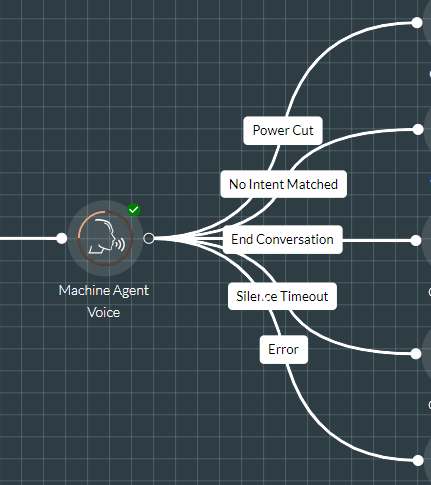Machine Agent Voice
|
Routes the contact according to a machine (chatbot) agent's interpretation of the caller's input in a voice conversation. |

The action cell uses a machine agent from a preconfigured project in the Dialogflow CX model on the Google Cloud platform. A Dialogflow project encapsulates a set of languages, geographical locations, machine agents, and caller intents associated with each agent. A caller intent is a group of phrases that has a common end goal. For example, an intent named 'Power Cut' might contain the phrases "I have lost all electrical power" and "I would like to speak to someone about a power cut" and is aimed solely at helping callers with power cut related problems.
When you configure the action cell with a particular machine agent for recognising spoken phrases in relation to a particular subject, you must choose the agent intent that contains the expected phrases. During a caller-to-machine agent conversation, if a phrase spoken by the caller matches a phrase in the chosen intent, the caller is routed along the exit point for that intent. You might choose to route that exit point to a destination (such as a queue) that is serviced by human agents who can deal specifically with that caller's queries based on their spoken phrases. You can choose multiple intents to extend phrase matching in caller-to-machine agent conversations.
The action cell allows you to store an intent's parameters (values extracted from the caller-to-machine agent conversation) as user variables for use elsewhere in your script. These parameters may be for system entities such as dates, times, email addresses, or they may be for custom entities such as a customer ID in relation to a customer account, for example.
Note: the action cell does not support duplicate parameter names in Dialogflow.
Note: the action cell supports a subset of the system entities available in Dialogflow. These are listed in the appendix.
A default fallback intent is associated with the machine agent. This is matched when none of the caller's phrases matches a chosen intent. You can configure the action cell to exit along a 'No Intent Matched' exit point when this fallback intent is matched numerous times.
Properties
Machine Agent Voice Section
A machine agent is associated with a particular project and location as configured in Dialogflow. As you may have access to many agents across different projects, you must select the agent's parent project and location.
|
Option |
Description |
|
Project |
Select the Dialogflow project to which the agent belongs. The list displays projects configured in Dialogflow and added to your organisation by Content Guru engineers at deployment. |
|
Location |
Select a country or region as defined in the selected project. For more information about agent location, see cloud.google.com/dialogflow/cx/docs/concept/region. |
|
Agent |
Select the machine agent (from the selected location) for interacting with callers. |
Options Section
|
Option |
Description |
|
Language |
Select the language that you expect the caller to use. This is list of pre-configured languages for the selected machine agent. |
|
Voice |
Select the voice to use for responding to the caller (for example, 'Female Standard A'). This list is filtered according to the selected language. |
|
Max attempts |
The number of times that the caller's input is allowed to match the machine agent's fallback intent (where the machine agent does not recognise a phrase) before exiting along the No Intent Matched exit point. |
|
The number of seconds to wait for the caller to speak either at the beginning of the conversation, or in response to the machine agent before exiting along the Silence Timeout exit point. |
Outputs Section
(Optional) This lists all of the intent parameters configured against the agent in Dialogflow. Use this section to store the parameter values in FLOW variables.
|
Option |
Description |
|
Parameters |
For a long list of parameters, use this to enter search text for filtering the list. |
|
<parameter name> |
Specify variables of the correct types to store the intent parameters.
|
|
Enter a string variable to store the name of the last intent matched by the action cell, so it can be used elsewhere in your script and in reports. |
Exit Points
|
Exit Point |
Description |
|
<Intents> |
This is taken when the caller's speech matches any of the machine agent's intents configured on this route. The branch is labelled according to the configured intents. You can create any number of Intent exit routes with multiple intents per route. A particular intent may be used on one exit route only. Note: you must select a machine agent and save the action cell before defining this exit point. |
|
No Intent Matched |
This is taken when the number of times that the caller's input matches the agent's fallback intent exceeds the value configured in the Max Attempts property. |
|
End Conversation |
This is taken when the conversation is deemed to have ended. It is based on the underlying fulfilment setting of the previously matched intent. |
|
This is taken when the timeout value specified in the Timeout property is reached at any point during the caller-to-agent interaction. |
|
|
Error |
This is taken if there is an internal error. |
